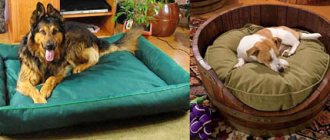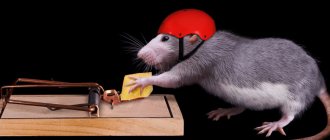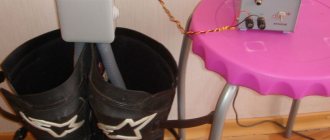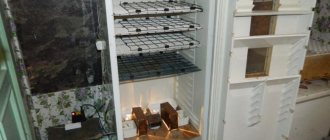- home
- Housing
16.07.2018
The hamster is a nimble animal that is very active at night. During daylight hours the animal sleeps. So that he has a resting place, you can make a house for your hamster with your own hands.
Design features of a house for rodents
Any structure installed in the cage must be made of environmentally friendly materials. Small rodents will definitely start sharpening their teeth on the house. Pieces containing harmful chemicals, once in the stomach of an animal, can cause its death.
It is advisable to divide the internal space into 2 zones: in one part of the home the pet will sleep, in the other - to store its supplies.
House dimensions
Before you make a hamster house with your own hands, you need to determine the dimensions of the pet. Djungarian or Syrian (golden) rodents are most often kept as pets. The body length and weight of animals vary depending on the species:
- Syrian - 13-13.5 cm, 100-125 g;
- Djungarian - up to 10 cm, 25-65 g.
The largest representatives of the hamster subfamily are animals of the species Cricetus cricetus, or the common hamster. Their body length can reach 34 cm. But such rodents are extremely rarely kept at home.
Determine the size of your pet before building the house.
When designing a house for a small hamster, you should adhere to the dimensions of the side walls 10x10 cm, the front and back - 15x10 cm, the roof - 17x12 cm. Depending on the size of the animal, these values increase proportionally.
Form
When choosing the shape of a pet's house, you need to consider the following:
- The interior of the structure must be easily accessible for cleaning.
- You should not leave wide gaps in the corners of the structure where your pet could get stuck trying to crawl through them. The inlet hole, on the contrary, should be large enough. Otherwise, a large rodent will not be able to get into the home.
The shape of the house depends on the type of building material and can be standard, semicircular, rectangular, etc. The dwelling is made one- or two-story. In the latter case, it is equipped with a ladder.
The floors in the house are not designed for rodents. They will interfere with cleaning the interior space from wool and debris.
The shape of the home should be such that it is convenient for the pet to move around in it.
Materials
A homemade design can be made:
- made of wood (thin planks, ice cream sticks, bars);
- peeled coconut;
- organic glass;
- food plastic;
- ceramics;
- vines;
- thick cardboard (toilet paper roll, box, etc.).
The structure can be made of wood.
In addition, remnants of fiberboard or chipboard are acceptable for use. It is forbidden to make a home for a rodent from polystyrene foam, polystyrene foam, polyurethane, OSB plywood, because they contain toxic substances and, if ingested by an animal, can lead to its death.
Home accessories
In order for the rodent to like the house and for the baby to grow up healthy and active in it, the housing needs to be filled with suitable accessories..
Educational toys for hamster
- Running wheel. Its dimensions depend on the size of the rodent: for the Djungarian it is a twenty-centimeter toy, for large specimens, including Syrian ones, up to 30 cm. The path on it must be continuous; it is not permissible to use a mesh for this, which can cause injury. It is important to know that hamsters like to stay awake at night, so the toy should be silent.
- Tunnels. They should be spacious and well ventilated.
- Hammocks for a hamster made from tubes of different diameters or a swing in the form of four posts, a crossbar and a perch for sitting.
- Wooden bridges or other objects for developing hamster teeth. It is good to use mineral stones and crayons. Cardboard boxes, toilet paper rolls, and branches of fruit trees are also suitable for these purposes.
- A walking ball made of safe plastic in different colors with ventilation holes and recesses for the paws.
Drinking and eating facilities
It is very important to choose the right feeder and water bowl for your rodent.
There must be a special drinking bowl in the house for drinking. You can make it yourself or use a bowl, which should be covered so that food or parts of the bedding do not fall into it. Small species of hamsters like to dig up pieces of food, so you can put them in the bedding. Large specimens require a stable food bowl that is difficult to tip over.
It is better to provide 2 containers - one for wet food and the other for dry food. Typically, rodents like to sit in the feeder, so it should be spacious enough. It is also important that there is a separate “pantry” for supplies that the hamster will definitely make. This could be a container in a secluded corner of the house. The hamster himself will “tell you” where his hiding place is, you just have to watch him carefully and then place a bowl there.
Hamster bedding
Bedding is very important for keeping the house clean and creating comfort and coziness. It can be pressed sawdust, but not too small so that it gets into the baby’s nose or gets tangled in his fur.
If wood pellets are used, they should be odorless and quickly turn into dust. Sawdust from coniferous trees can cause allergies in the animal, and fabrics and cotton wool are dangerous because they can tear into fibers in which the hamster can become entangled.
The best bedding materials for a hamster in a house are pieces of corn cobs with kernels, which can also be buried. Paper napkins or white unscented toilet paper are suitable for this.
The floor layer should be at least 6 cm deep, because hamsters love to play and burrow into it. When it gets colder, its thickness increases. It needs to be cleaned daily and changed once a week. A little granules from the previous bedding should be added to the fresh litter so that the familiar smell remains, otherwise the animal will become nervous.
Toilet
Hamsters are known for their cleanliness, so they need a separate place in the house for the toilet. You will have to clean it daily, removing waste and adding clean bedding. A cardboard tray is well suited for this purpose; this material is replaced quite often, because... it absorbs urine well, partially absorbing its odor.
The litter filler is often special clean sand, which the animal likes to rummage in, scattering it around. But sand does not hold odors well, so it needs to be changed often. Cat litter or mineral granules are not suitable for this - they can cause poisoning or allergies in your furry friend.
Sand bath
This is an important element of equipping a house for a hamster that does not like water treatments. They can be successfully replaced by bathing in special sand for chinchillas. To clean the fur from grease and dirt, place a high container with a ladder in the house. Let's assume an option with a hole cut in the side. It is closed on top with a lid that prevents the contents of the container from spilling out. The volume of the bath should be twice the size of the furry pet, and its sides should be high enough.
How to choose materials for a hamster house
If you want to build a house for a rodent, you should focus on the durability of the structure. So, a home built from cardboard will not last long. It will only be a temporary shelter. A structure made of wood is more reliable, but a pet can chew it quickly enough. The strongest houses are made of glass, food-grade plastic and ceramics. They are reliable, durable, easy to wash during cleaning and clean from dust.
Lego structures, hollow parts from children's toys, glass and plastic jars and containers, etc. can be used as housing for a hamster.
A house made from a stand for toothbrushes or stationery will look original.
Where is the best place to place a hammock in a cage?
In order for the hamster to show interest and actively use the hammock for its intended purpose, it must be hung correctly in the rodent’s home. It is useful to consider the following points:
- Optimal height: the pet should easily climb into the hammock and get out of it without the risk of injury. A cradle located near the floor will often get dirty and interfere with the hamster's ability to move around the cage. Therefore, it is recommended to hang the product at a height of 5–10 cm from the bottom of the cage.
- Hammocks for hamsters should be placed where the animal likes to rest. The location should not coincide with the feeding or toilet area. It is best to place the bed on the second level of the home.
- The fastenings for the hammock are chosen to be reliable and durable: the bed should not move or turn inside out. The clamps must be universal and secure the product in any part of the cage.
- The owner should be able to easily remove the cradle if it needs to be washed or repaired.
You can make many accessories for a hamster with your own hands. A hanging bed in this regard is no exception. It will not only bring great benefits to the pet, but will also create comfort and decorate the house.
What is needed to build a house
When starting to arrange a home for a rodent, stock up on the necessary materials and tools. Suitable for filling:
- pieces of paper and napkins;
- large sawdust.
Large sawdust is suitable for arranging a house.
They can be placed in the hamster’s house or left near the structure. The animal will carry everything on its own and put it in the place where it will be more convenient for it. Do not place fabric, cotton wool or wool in the cage. Fibers from such materials can get into your pet's stomach and cause indigestion. In addition, it is undesirable to use scraps of newspaper sheets, because... Printing ink may contain compounds harmful to the health of the animal.
Tools
Depending on the type of dwelling, the following are used as devices for the manufacture of structures:
- knife or scissors;
- ruler;
- sandpaper;
- awl, etc.
Some designs will require pre-production of a template.
Shelter drawing
If the owner does not plan to use a ready-made structure as a shelter for the hamster, it is necessary to make a drawing. It is designed taking into account the size of the pet and the shape of the structure. The home should not be too cramped or spacious. For a large Syrian hamster, it is enough to equip a house 16 cm long, 8 cm wide and 7 cm high.
Drawing of a house for a hamster.
If the structure will be assembled from several elements, for example plastic bottles, the joints are marked on the diagram. On the drawing of a two-story dwelling, a staircase is drawn.
Making simple tunnels
A hamster cage must contain at least one small tunnel. And for games outside the home, complex structures of medium and large size are suitable. You can make a permanent entertainment room for your furry friend or build the attraction anew each time, changing its size and direction of moves.
Children are showing great interest in creating entertainment for hamsters. We invite you to study the instructions for creating simple tunnels that even a schoolchild will understand.
Paper tube for cage
The simplest option is to use a cardboard paper towel tube as a building material. You can put it in the cage unchanged or make windows in the tube so that the animal can come out through them.
The sleeve tube can also be installed in external cardboard labyrinths.
Game room
Do your kids love to play with and watch hamsters? Then give them an idea: make a tunnel for a hamster from an unnecessary cardboard box. The kids will happily get down to business, use their creative imagination and create an attraction with love.
There are a lot of construction options. We will tell you how to make a hamster maze in two different ways.
- The first method does not involve the use of glue. Take a box and pieces of cardboard: 3 strips should correspond in size to the length of the room, 5 to the width. On long pieces, make 5 cuts at equal distances from each other, and cut short pieces three times. Between the cuts, cut out doors, windows and holes for pipes. Now we can assemble our room. Install long partitions with the cuts up, and insert short parts into them with the cut down. You will get a lattice. If you have pipes planned, insert them into the round cutouts. Place the grid in the box and you can start playing right away!
- The second method is based on gluing the walls. It is good because you can create a variety of branches, as well as a rest room for a small creature. To glue the walls, use regular or construction tape.
Labyrinth from a construction set
Preschoolers and schoolchildren love to build various castles and fortresses from construction sets. Invite them to make an attraction for a hamster - they will happily complete this task. Moreover, children themselves know how to make a labyrinth for a hamster from Lego constructors interesting and convenient.
If you are building a walker for a dzhungarik, small parts are better suited. For the larger Syrian breed, use medium sized pieces. Using a small construction set inside the maze, you can build a small obstacle course for the animal, at the end of which you can place a tasty nut.
Book fortress
Old hardcover books are suitable for creating a large, spacious tunnel. To do this, they need to be placed with their roots facing up. It is better to completely enclose the space with books so that the hamsters do not run away in different directions. For one animal, the width of the passage can be 5-8 cm (so that the animal can easily turn around in it), but if you have several fluffies, the tunnels should be more spacious.
In such a book fortress, kids really love to have hamster races. Rodents are placed in a common closed room, after which they open the “door” and watch which of the animals gets to the exit first
At the same time, it is important to ensure that race participants do not violate the rules. If a cunning hamster climbs over the wall, he must be brought back
A maze made from books can also be used to train animals. To do this, you need to place small pieces of tasty food along the chosen path, and repeat the operation several times with the same route. Then you should place the treat only at the exit. You will be surprised how quickly your smart hamster will find it!
Tunnel made of plumbing parts
If your apartment has recently been renovated and you still have unnecessary parts for connecting pipes, use them to create a branched labyrinth! This attraction is suitable for both small Djungarian and larger Syrian and Caucasian hamsters. By the way, the tunnel made from plumbing looks very original. Another advantage is the collapsible design of the attraction, which means you can periodically change the direction of the moves.
Making it is very simple: connect the parts in any direction. It will be more interesting for the hamster to play if there are several exits in the pipe. But in this case, do not leave the home unattended, otherwise you will have to look for it throughout the apartment!
Step-by-step instructions for making a hamster house
When arranging a home for a rodent, try to avoid the use of small parts and sharp corners. The design should be comfortable and safe for your pet.
From plastic containers
Housing made from plastic bottles is easy to make and install. It can be replaced at any time with a new design. This house is suitable for both small and larger animals.
For the first option you will need to take:
- 2 drink bottles of 1 and 1.5 liters;
- scissors;
- stationery knife;
- electrical tape.
The necks of the bottles are cut off. Then the edges of the cuts are carefully covered with electrical tape. This is necessary so that the pet does not get hurt on the sharp edges of the plastic when using the structure.
Then a hole is cut in the side of the 1.5-liter container, the size of which is equal to the diameter of the second bottle. As a result of such manipulations, the plastic may crack, so first of all, a hole in the shape of a cross is made in the wall. Then, using scissors, it is enlarged. Treat the sections with electrical tape and insert one container into another. The structure in the shape of the letter “T” should not fall apart; for reliability, it is wrapped with electrical tape.
The house can be made from plastic containers.
To make the home more comfortable for pets, the transparent plastic outside can be covered with dark paper. This will prevent the penetration of light, which can interfere with the hamster's sleep.
The second housing option can replace the cage. To make the structure you will need to take:
- Several containers with a volume of at least 5 liters. Each bottle will be used as a separate room for your pet. The owner himself determines their number and the size of the home.
- Scissors.
- Electrical tape.
Then you need to cut off the top of the containers so that plastic funnels about 3 cm deep with a neck at the end are formed. The covers need to be removed. The sections are covered with electrical tape. A hand should be able to fit into the bottles; this will allow you to clear the pet’s home of debris. Holes equal to the diameter of the neck are made in the lower part of the flasks. Then the containers are connected to each other by inserting a funnel into one bottle and screwing the neck into the wall of the other. It turns out several separate spaces connected by transitions.
One of the flasks can accommodate a wheel and a hammock, creating a playroom. In the second they install a feeding trough and water bowl, in the third - a toilet, in the fourth they set up a bedroom for a pet, etc.
From cardboard and boxes
The simplest option for arranging a home made of cardboard is to use a ready-made box for shoes or other small items. The container is cut to the required size, then an inlet hole is made. Cardboard houses for dungeons can be equipped with transitions made from toilet paper rolls. This option is not suitable for Syrian hamsters - large animals can get stuck in the tunnel.
A simple house is made from cardboard and boxes.
It is not advisable to use juice or milk cartons that are lined with foil on the inside and do not allow air to pass through.
From a plastic container
Have to take:
- food container of a suitable size;
- sharp knife;
- lighter or matches.
The container is installed upside down. Then use a knife to cut the entrance hole. The edges of the plastic are melted with a lighter or matches so that they become smoother and the pet cannot get hurt.
For the house, take a food container of a suitable size.
Plastic boxes for storing cereals can also be used for rodent living. Such containers are equipped with lids with a hole through which the pet can get inside. The box is laid on its side. At the bottom of the container you need to pour sawdust from hardwood or lay scraps of clean paper.
Wooden house
To make a simple design you will need to take:
- a wooden board no more than 1 cm thick;
- ruler;
- pencil;
- jigsaw;
- sandpaper;
- hammer;
- thin small nails.
A wooden house is cut out of parts.
4 parts are cut out of the board, corresponding to the size of the pet. For example, 2 will have a length of 13 cm, and 2 others will have a length of 15. An inlet hole is cut in a small workpiece. In the walls 15 cm long, you can make small windows through which air will penetrate. The cuts must be thoroughly sanded with sandpaper.
The parts are then knocked together into a single structure.
You need to make sure that the point of the nails does not stick out from the wood, otherwise the animal may be injured.
A thin plywood sheet of the required size is used as a ceiling.
From coconut shell
This house is suitable for small hamsters, such as dwarf hamsters. To create a home you will need to take:
- coconut;
- hacksaw;
- knife;
- sandpaper;
- square wooden stand.
A house for small hamsters is made from coconut shells.
The nut is opened, removing the milk. Then, using a knife or hacksaw, an entrance hole is cut 2 cm below the eyes. Thoroughly clean the shell from the pulp, wash it and leave it to dry. Afterwards, the cuts and surface of the walnut are sanded using sandpaper. The finished product is attached to a wooden stand with glue or a screw.
From plywood
To build a home they take:
- a piece of plywood;
- ruler;
- pencil;
- jigsaw;
- hammer;
- small nails;
- sandpaper.
Plywood is used to build a home.
2 side walls measuring 10x10 cm are cut out, the front and back are 10x15 cm each. For a large hamster’s house, the size of each part must be proportionally increased by several centimeters. For the roof, take a sheet of plywood 12x17 cm. It is advisable to make windows in the side walls for additional ventilation.
The parts are sanded with sandpaper, then knocked together into a single structure. The roof is placed on top.
From old toys
Plastic parts from toys can be used as a home for a hamster. For example, this could be the head of a large doll or the cab of a truck. Using a hacksaw or soldering iron, make an inlet hole in the part, then remove the burrs by sanding the sections with sandpaper.
A ceramic figurine can also serve as a home for a small hamster. You will need to make an entrance in it using a jigsaw or a manual tile cutter. Such a ceramic house must have additional holes for air intake.
From paper
This type of housing is suitable for small pets. You will need to take:
- toilet paper or napkins;
- balloon;
- bowl of water.
To make a house, the ball is covered with paper.
The balloon is inflated so that its diameter matches the size of the future house. Paper or napkins are torn into pieces and placed in a container with liquid. Then they spread it over the surface of the ball, forming a small inlet hole. You will need at least 8 layers of paper. The papier-mâché is then dried using a hair dryer or battery.
The ball is pierced with a needle and removed. If necessary, adjust the size of the passage for the animal.
From the constructor
You can create an unusual shelter for your pet using LEGO construction kits. If there are a sufficient number of elements, you can create several rooms by connecting them with tunnels. To prevent the rodent from taking away small parts, it is recommended to fasten them with glue.
Choosing the right cage
Buying an animal begins with purchasing an “apartment”. Let's figure out what a hamster cage should be like in order to balance the appropriate living space and meet the standards of a healthy living environment.
- Size. You need a cell of a certain area. Too small - all the necessary accessories will not fit inside; too large - the animal will feel discomfort.
- Base. The solid plastic bottom with rounded corners makes cleaning much easier, and dirt can remain in the pull-out tray.
- Rods. The ideal option would be metal, unpainted rods made of high-quality metal, with a frequent arrangement of cells. A hamster living in a cage with too wide openings between the bars will definitely escape.
- Door. Despite its small size, the animal is quite strong; the exit must have a reliable lock that the animal is not able to open or bend. If the cage has two floors, doors should be located on each. This will make it easier to clean and catch the animal if necessary.
If you first got a male, and then plan to get another female, you will need large housing. This is usually achieved by adding a second floor, rather than by having an impressive footprint. By purchasing such a cage, you can save money by not purchasing factory accessories.
Let's look at how to make the second floor of a hamster cage yourself. A lot of improvised items are used for production. The only condition is the absence of sharp parts that could injure the animal. It is necessary to make a platform and a ladder to it.
It is desirable that both surfaces are solid, without holes where a hamster's paw could fall through. Be sure to firmly fasten, or better yet glue, all the parts, because the animal is quite energetic and can knock them over or knock them over during play. The good thing about making it yourself is that you can fix a broken part without investing money.
You can also make nesting houses for hamsters with your own hands, where they store supplies, rest or sleep. To do this, you will need objects without sharp elements, with which you can create a cozy corner. Be sure to make several ventilation holes of small diameter so that the animal cannot crawl through them.
Photo examples of interesting homemade products
By making a shelter for rodents yourself, you can make all your fantasies come true. The main thing is to remember that the animal should be comfortable in its home.
A paper house requires minimal investment.
A wooden house will last a long time.
A house made from plastic containers is very convenient.
Useful video
Do you want your hamster to remain cheerful and agile? Do you want him to never get bored? Do you want to provide him with every opportunity for physical and mental activity? Like the one that wild hamsters get during their nocturnal adventures?
Then it is necessary to provide your pet with interesting activities, both in the cage and outside it - on the playground.
Go to a pet store and browse the sections that sell hamster supplies. You will see a wide variety of toys and entertainment equipment. You'll find wooden molds with holes for the Syrian hamster, grass and bamboo balls and grass tunnels for the hamster to hide in and chew on, as well as colorful cars, shoes, trucks and planes for the hamster to climb on or crawl inside. The question arises: with such wealth, how can you choose what your hamster will like? Will your golden hamster climb stairs or swing on a swing, will it go into a prefab or grass tunnel, a rocket or an airplane? Unfortunately, it is impossible to predict for sure which toys he will like and which he will not. But fortunately, toys for hamsters are usually not very expensive, so a toy rejected by your pet won't cause much damage to your budget.
Please note that all animals are very different. For example, Goldn likes variety in her life and can very quickly lose interest in a toy that she has already explored hundreds of times. Even the best toys can become boring if played with for too long. (Isn’t it like that with us?) Therefore, constantly offer new toys to your pet, put away the old ones and after a while put them back. Or combine and rearrange old toys to give them a new twist. That is, do whatever you want to make life interesting for your hamster.
And don't forget to inspect your toys regularly. Check to see if they have become unusable or chewed. Don't be sorry, throw away any overly chewed toys if you think they are unsafe for your hamster's health.
Spin, spin, wheel.
The first thing you will notice on the shelves of a pet store is the abundance of hamster wheels. Almost all hamsters enjoy running on a wheel; no training is required. Revisiting the “Wheel Activity” in Chapter 5 will help you decide on the right wheel and help you remember information about how to use them and the problems that arise.
Tubes and tunnels
Please note that there cannot be too many tubes and tunnels. After all, in the wild, hamsters spend their days hiding and sleeping in a labyrinth of underground tunnels. So if you don't have a cage system with connecting tubes, it might be a good idea to build an obstacle course on your playground. Attach straight and right-angled plastic tubes to spigots, tees and six-hole cubes to create an interesting labyrinth. Fortunately, you don’t need to purchase everything at once; you can build such a labyrinth, piece by piece. And to keep Goldn always interesting, rearrange the sections more often, creating new configurations.
Possible problems and their solutions
Animals do not always evaluate their owner’s work positively. Hamster owners often encounter situations where their pets use their home for other purposes.
The rodent does not sleep in the house
There are several reasons why a pet does not sleep in a shelter:
- the building material or bedding is of poor quality;
- the animal uses the structure to store supplies;
- transparent walls and large openings do not allow the rodent to feel safe;
- the dwelling is too small and lacks ventilation.
In addition, hamsters may not immediately determine the purpose of houses. This often happens when you have to replace an old design with a new one. To help the animal, you need to put an object from an old house in the home.
Hamster goes to the toilet in the shelter
To wean your pet from this habit, you will need to place the structure in the cage on a tier higher than the toilet. In addition, it is recommended to place the wet filler in the corner opposite the corner in which the home is located.
Housewarming: introducing your pet to its new home
A hamster, like any other pet, needs time to adapt to a new home and owner.
A newly acquired hamster, being in a state of stress, is afraid of everything. It will take him at least a week to gradually get used to the new house. During mastering, it is better not to disturb the baby. Once he gets comfortable, he begins to actively mark his territory, so you shouldn’t change the bedding at first.
Hamsters are inquisitive by nature, so sooner or later, if the baby does not feel danger, he will show interest in exploring the house and will definitely examine it.
It is important to toilet train young animals immediately. They themselves will designate a convenient place for it. By carefully observing the behavior of a new settler who has settled in, you can correct mistakes in the equipment of his house by making some rearrangements or improvements to suit his taste.
For example, when the playing wheel is poorly secured and makes sharp sounds when moving, the hamster gets scared and does not play in it. After strengthening, lubricating the axis of rotation or replacing it with a less noisy option, your furry friend will happily run and tumble.
Types of hamsters that can be kept at home
Of the variety of hamsters, only a few species are kept at home.
Below are the most common domestic hamsters and their photos.
Pre-Asian hamster
The most popular species for keeping at home is the Central Asian or Syrian hamster (Mesocricetus auratus). Very little is known about its life in the wild. In 1839, the first representative of this species was described, found in the Syrian desert. For a long time it was believed that the pre-Asian hamster was extinct, but in 1930 a female and her litter were captured in Syria and then taken to Israel. A single family in captivity quickly multiplied, and the species was introduced to pet owners in the 1940s.
Today the Syrian hamster is one of the most popular pets.
He is quite unpretentious, has a calm character, and what is very important, rarely gets sick
The body length of the Syrian hamster does not exceed 14 cm, and its weight is 250 grams. The animal's tail is so short that it is practically invisible due to its fur. Its natural color is golden, although breeders have developed a large number of color variations: if desired, it is not difficult to find white, beige, gray and even black animals. In addition to the solid-colored varieties, patterned types have been developed: tortoiseshell (with large white, yellow spots, and tricolor), with a white belt around the body, and spotted. Eyes may be black, red or pink.
However, breeders went further and bred animals with three other types of coat, each of which can have different colors.
In the photo below, the so-called “Angora” hamster is essentially the same Syrian, only long-haired.
The Syrian hamster, with its thick, tousled, wavy fur and curly mustache, is called the royal hamster.
With the satin type, the coat is short, smooth, and surprisingly shiny.
Djungarian hamster
Another popular species for home keeping is the Djungarian hamster (Phodopus sungorus). It is smaller in size than the Syrian (its body length is 7-10 cm), but is even more active at night.
The external feature of this species is a narrow black stripe running along the animal’s spine. Its coat is not very long, with white patches.
Roborovsky's hamsters
This dwarf species has a body length of no more than 5 cm, the tail is hidden in a thick fur coat. The fur of the Roborovskiy hamster (Phodopus roborovskii) is golden sandy in color; A characteristic feature is the white brow ridges in the form of a mask. In nature, they live in Mongolia and Northern China.
They are great pets to watch, however, they are not as friendly as Syrians and are more difficult to communicate with. They are very nimble, can make amazing jumps, but are not able to sit on their hands for even a second.
And if it is better to keep Syrian and Djungarian hamsters one at a time, since in a confined space they will fight among themselves, then Roborovsky hamsters can be kept in pairs and groups - they are not aggressive towards their relatives.
Campbell's hamster
These hamsters are similar in appearance to Djungarian hamsters, differing from them in a thinner and more diffuse stripe on the back. In addition, Campbells (Phodopus campbelli) can be spotted, and their fur is not smooth, but in tufts.
In nature, they are found in Kazakhstan, Mongolia, and northern China. In Russia they inhabit Transbaikalia, Buryatia and Tuva.
Thanks to breeders, domestic Campbells can have a variety of colors; in nature, the color of their fur coat is dark gray with a brownish tint.
Delicious "walnut" staircase
From the empty shells of several walnuts you can make an excellent toy for your pet. In addition to the empty shell halves, you need to prepare in advance:
- a thin nail with a sharp end;
- hammer;
- a strong thread as long as the height of the cell;
- medium size washer.
In all prepared half-shells, you need to carefully make a hole in the center. This is done by driving a nail (there is no need to leave it in the resulting hole). You need to thread a thread through the holes to make the shells into a kind of beads. An important nuance - all halves must be turned in one direction, with the exception of the last one. In a vertical position, the beads look like a stack of bowls standing on a tubercle.
A washer is tied to the end of the thread coming out of the last (lower) shell so that the thread is securely fastened and the structure does not fall apart. The upper end of the thread is tied to the “ceiling” of the cage so that the lower shell lies on the bottom, but the “beads” do not sag. You need to put treats for the hamster in all the resulting bowls. Climbing the structure, the pet will take away a tasty prize at each stage of “conquering the peak”.
The height of the structure must be respected. Hamsters climb beautifully, but they descend simply by jumping. Therefore, you should not use shells from more than several nuts for one construction. In addition, it is important to provide your pet with a soft landing - the bedding in the area of the toy should be thick.
Do-it-yourself is always more interesting
Making your own pet accessories is always more fun. Many owners do not even take on making toys because they believe that it is too difficult a task that requires special skills.
There are many options for making accessories for rodents, which require only available materials and a little time.
Hamster toys
Hamsters in nature are forced to spend a lot of time searching for food and fleeing from predators. They don't have time for special games. In captivity, animals often become overweight due to their conditions: small cages and insufficient equipment.
Therefore, in order to create ideal conditions for animals, it is necessary to properly equip the cage and fill their leisure time with special devices. Since it is unwise to put hamsters in danger by having a predator, toys should work in two directions:
- searching for food;
- physical activity.
For the first, grass balls in which a treat is buried, various types of sandboxes and structures with seeds inside are suitable.
Labyrinth of bottles
A labyrinth from bottles or PVC pipes can be made quite simply and quickly. A hot knife is used to shorten and correct the shape of the joints. To fasten bottles or pipes together, you can heat them or use non-toxic glue.
When making a labyrinth, it must be equipped with several “emergency” exits in case the hamster gets stuck. It is advisable that the layout of the labyrinth is not too complicated, since over time, the hamster will drag bedding into it and cleaning will be required.
Signs of hamsters appearing in a summer cottage
Wild species of rodents are not afraid of humans. Fighting hamsters in the garden is a troublesome task. If there is a lot of food in your area, then the animal will live peacefully and often not in one copy.
At a time when his reserves are in danger, he can put up violent resistance and attack a person, protecting his bins.
Signs of a rodent appearing in a suburban area are:
- Presence of holes and tracks.
- Numerous passages and paths along which animals move.
- Digging for tubers.
- Damaged fruits or their remains after being eaten.
- The bark at the bottom of trees or bushes has been eaten.
A single effective method of exterminating wild hamsters has not yet been invented. Everyone chooses for themselves the most acceptable method from many existing ones.











